Theory of Light and Color

20. The Human Eye and the Camera Eye (Part 3)
Controlling Camera Exposure
In the past, cameras were set up manually, and poor settings lead to out-of-focus images or overexposure/underexposure. Most modern cameras can easily take pictures with proper exposure and focus by simple point-and-shoot.
This section explores how a camera controls parameters to automatically achieve proper exposure.
Relationship Between Control Parameters
Each exposure parameter is specified by a power of two numerical series. If, for example, you slow the shutter speed by a step (increase the exposure time by a step) by setting the value from 1/60 to 1/30 seconds, you double the exposure amount.
Moreover, if you change the F-number from F4 to F5.6, the illuminance on the imaging surface will be reduced by 1/2. These series AV, TV, BV, and SV represent the actual values of aperture, exposure time, subject luminance, and sensor sensitivity.

Reflective Exposure Control: Determining Exposure by Measuring Reflected Light (Luminance B) of the Subject
The previous section introduced the conditional expression for proper exposure:

If we move the factors that can be controlled by the camera (aperture value A and exposure time T) to the left side in the above equation, it becomes

If we transform this slightly to
 (N = 0.32 constant ≪1≫)
(N = 0.32 constant ≪1≫)
And apply a logarithm of 2 as a base to both sides, we get:

If we define AV, TV, BV, and SV as shown on the right, the resulting equation is
AV + TV = BV + SV = EV
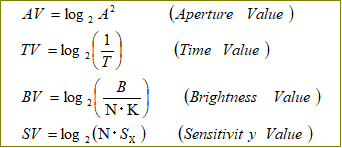
This equation shows the relationship between exposure control parameters when proper exposure is obtained through reflective exposure control, where EV represents exposure value. This is called the APEX system. (APEX = Additive System of Photographic Exposure)
BV + SV = EV means that the appropriate exposure value is determined by luminance and sensitivity (regardless of aperture and shutter speed). Constant K in BV is the calibration constant of the reflected light meter. K is set so that the measured subject (luminance B) is properly exposed relative to the sensitivity Sx. ≪2≫
On the other hand, if you look at AV + TV = EV, the exposure control value is determined by the aperture and shutter speed (regardless of the subject and sensor). ≪3≫ So based on APEX, you achieve proper exposure when the exposure control value balances with the appropriate exposure value.
Exposure Control Programs
A camera equipped with an auto exposure function uses the camera's built-in sensor to measure the subject luminance B to obtain the BV value, which is then used to calculate the appropriate exposure value EV based on the sensitivity (SV value) of the camera. The EV value is then divided into an AV value (aperture value) and a TV value (exposure time or shutter speed) for exposure control. Various combinations of AV and TV values are possible for a given EV value. Programmed exposure control is when these combinations are predetermined (programmed) according to the objectives and imaging conditions.
Image capture for fast-moving objects requires a high shutter speed (ex. 1/1000 sec). To get proper exposure, the camera automatically opens the aperture according to the shutter speed and subject luminance (shutter priority mode). Conversely, if you want a deep depth of field, you need to stop the aperture down and slow the shutter speed accordingly (aperture priority mode). ≪4≫
Standard program control mode is a function common in compact cameras for beginners. Some combinations of the aperture and the shutter speed are preprogrammed over the maximum range of exposure value (EV) the camera can handle. Exposure control is performed accordingly, so you can get a “good enough” picture over a wide subject luminance range by simply pressing the shutter button without setting a specific aperture or shutter speed. ≪5≫
The above is an explanation of reflective exposure control, where the camera measures the subject luminance (light reflected by the subject) to perform automatic exposure control.
Incident Exposure Control: Determining Exposure by Measuring Incident Light (Illuminance I) to the Subject
Incident exposure control measures the brightness (illuminance) of the illuminated subject surface instead of the reflected light.
Consider the illuminance of a light source on the subject surface is I [lx].
The light from the light source is reflected by the subject surface (reflectance ρ0 ≪6≫) and captured by the camera.
The relationship between luminance B and illuminance I on the subject's reflective surface (reflectance ρ0) is proportional and can be written as
B = k 3 ・ ρ0 ・ I (k3 is constant)
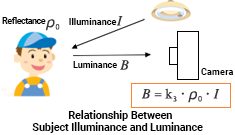
Substituting the above into the conditional expression for proper exposure, we get

C is constant, and C = K / ( k 3 ・ ρ0 ).
If IV is defined as shown on the right,

AV + TV = IV + SV = EV (As in the case of the reflective exposure control)
This is the APEX concept for incident exposure control. Notice that the reflectance ρ0 of the subject is included in the calibration constant C. This means that the subject with reflectance ρ0 is properly exposed.
If part of the subject in the scene has reflectance ρ > ρ0, it will have higher exposure than the area of ρ0. Conversely, a part of the subject with reflectance ρ < ρ0 will have lower exposure. This ρ0 is usually set as the average reflectance of various parts of the scene and is used to calibrate the incident light meter accordingly.
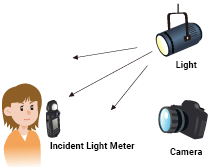
| Reflective exposure control | Incident exposure control | |
|---|---|---|
| Method | Appropriate exposure level based on subject luminance. | Appropriate exposure level based on subject reflectance. |
| Reflectance of the subject scene is high | Even a white subject appears gray. To get proper exposure: Shutter → speed up Aperture → stop down |
Regardless of the subject’s reflectance, the exposure control value EV (= AV + TV) is determined by the subject surface illuminance I. |
| Reflectance of the subject scene is low | Even a black subject appears gray. To get proper exposure: Shutter → slow down Aperture → open more |
Average Metering and Spot Metering
As shown in the table above, the area of the scene where luminance is measured appears properly exposed in reflective metering. The overall image is affected by this area.
A standard camera determines exposure conditions that ensure general image quality by measuring the average luminance over a large area of the entire photograph. However, a scene such as a person against a snowy landscape has an extreme luminance distribution, and the bright background will be moderately exposed while the person looks dark.
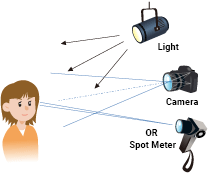
In such cases, if you use a luminance measuring instrument (spot meter) with a narrow measurement angle, you can measure the luminance of a small area, such as the person’s face, to determine moderate (proper) exposure.
When using incident metering, you can properly expose a subject that has an average reflectance (person’s face) regardless of a background with extreme reflectance (snowy landscape).
Exposure Control in Flash Photography
When using continuous light, the subject luminance B does not change (B is constant), so the exposure amount of the imaging medium is a product of the illuminance (E) and the exposure time (T).
Therefore, for the different luminance of the subject, you can obtain proper exposure by adjusting the exposure time.
However, in flash photography, light fluctuates during the exposure time, so subject luminance B is a function of time and is not as simple as continuous light photography.
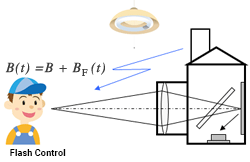
The camera measures these changes in real-time, monitoring the sensor-metric exposure as it increases over time and stops the flash once the sensor-metric exposure reaches proper exposure.
Suppose that B represents the luminance of the subject illuminated by continuous light and that BF (t) is the subject luminance when there is only flash illumination and no continuous light. Then the actual subject luminance when using flash photography can be expressed as
B (t)= B + BF (t)
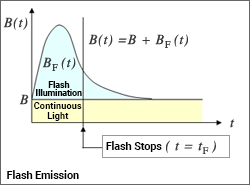
The quantity of light Q1 reaching the film surface can be expressed as a function of time as follows.

The camera monitors the changes in Q1(t) and stops flashing when Q1(t) matches Q2(t).
That is, if Q1 matches Q2 when t equals tF, the proper exposure condition is

The flash emits light by rapidly discharging the charge stored in the capacitor. Even if a signal to stop flashing is sent once Q1 matches Q2, a slight time delay occurs before the light emission stops completely. This means overexposure, where Q1 > Q2.
As a countermeasure, the stop signal is sent earlier by using a pseudo-sensitivity value SX’ (SX’>SX) which is more sensitive than the sensitivity value SX of the sensor and results in proper exposure.
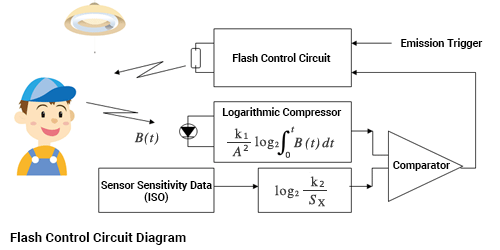
Comment
≪1≫ The value of the constant N
The APEX system converts the exposure control value to a logarithmic value (base 2) so that the amount of change in the multiple series of each control value is represented by an integer (1, 2, 3,…).
The sensitivity SX is represented by the ISO value (…, 25, 50, 100, 200, 400,…) as a multiple series. When converting this ISO value to an SV value, if you convert it to a logarithm (base 2) as is, it will not be a whole number.
The conversion factor N=0.32 was introduced so that the most common ISO sensitivity of 100 becomes an integer value of SV = 5.
For SX=100, SV = log2 (N・SX) = log2 (0.32×100) = log2 (32) = log2 (25) = 5
≪2≫ K (calibration constant of the reflective light meter)
The calibration constant K of the reflective light meter is usually set at 10.6 ~ 13.4 so that the average reflectance of the subject area (about 18%) produces moderate exposure, depending on the imaging medium.
≪3≫ Exposure (control) value EV
The figure below is the graph representing the EV as the various combinations of the camera control values AV and TV (EV = AV + TV).
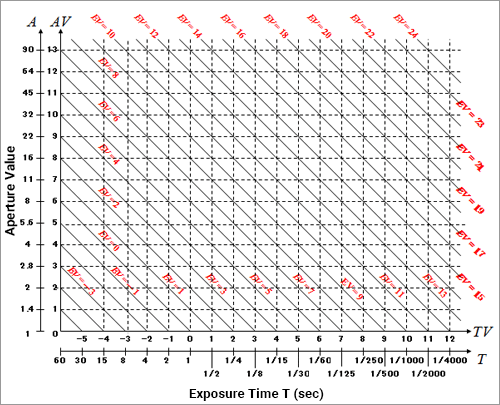
≪4≫ Shutter priority mode and aperture priority mode
Consider a camera that has a shutter speed setting (variable) ranging from 30 to 1/2000 seconds and an aperture setting (variable) ranging from F2 to F64. The light blue area is the variable exposure control range. The red line is a control line for shutter priority mode in an example where the shutter speed is fixed at 1/1000 seconds. In this case, a part of the subject area with an exposure value EV over 22 will be overexposed (EV is determined by subject luminance BV and sensor sensitivity SV (EV = BV + SV)). Conversely, parts of the subject area with an exposure value EV less than 12 will be underexposed.
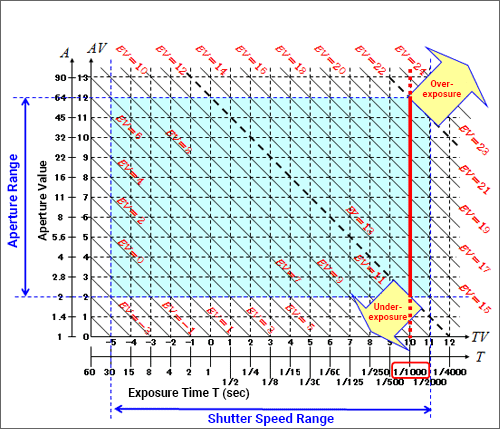
The red line is a control line for aperture priority mode with the aperture fixed at F2.8. In this case, parts of the subject area with an EV over 14 will be overexposed, and areas with an EV less than -2 will be underexposed.
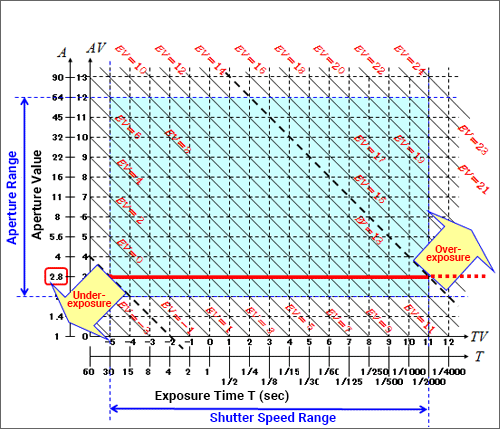
≪5≫ Standard program control mode
The figure below is an example of the standard program control mode. The combinations of shutter speed (TV) and aperture (AV) are determined in advance for the proper exposure value EV (= BV + SV), and the camera uses the corresponding shutter speed and aperture for the EV value measured at the time of photographing.
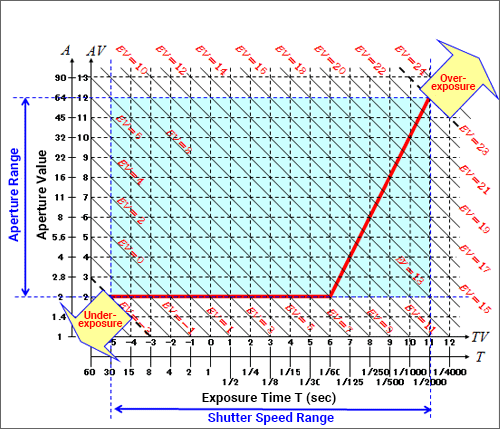
In this program control, various control diagrams are put into practical use depending on how the effect of shutter speed and aperture is produced.
Take for example anti-shake mode and portrait mode in cameras. The former prioritizes high shutter speeds while ensuring proper exposure to minimize camera shake when the shutter speed is slow, and the latter has a program that opens the aperture to blur the background.
≪6≫
Here, we used the term reflectance to make it more intuitive, but technically speaking, we are referring to the luminance factor.
The Human Eye and the Camera Eye (Part 3)
Controlling Camera Exposure

